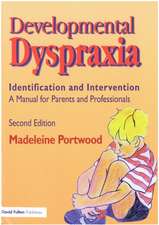Effective Instruction for Students With Special Needs: A Practical Guide for Every Teacher
Autor Bob Algozzine, James E. Ysseldykeen Limba Engleză Paperback – 22 mai 2006
o Planning Instruction: deciding what and how to teach while communicating realistic expectations
o Managing Instruction: preparing for instruction, using time productively, and creating a positive environment
o Delivering Instruction: presenting content, monitoring student learning, and adjusting instruction
o Evaluating Instruction: monitoring student understanding and engaged time, recording student progress, using data to make decisions, and making judgments about student performance
For cases in which more than slight adaptations may be necessary, this helpful guide also highlights special instructional aids and specific teaching methods proven to enhance the success of students with special needs.
| Toate formatele și edițiile | Preț | Express |
|---|---|---|
| Paperback (1) | 182.52 lei 6-8 săpt. | |
| SAGE Publications – 22 mai 2006 | 182.52 lei 6-8 săpt. | |
| Hardback (1) | 443.59 lei 6-8 săpt. | |
| SAGE Publications – 22 mai 2006 | 443.59 lei 6-8 săpt. |
Preț: 182.52 lei
Nou
Puncte Express: 274
Preț estimativ în valută:
34.93€ • 36.56$ • 29.07£
34.93€ • 36.56$ • 29.07£
Carte tipărită la comandă
Livrare economică 31 martie-14 aprilie
Preluare comenzi: 021 569.72.76
Specificații
ISBN-13: 9781412938976
ISBN-10: 141293897X
Pagini: 128
Dimensiuni: 152 x 229 x 8 mm
Greutate: 0.24 kg
Ediția:New.
Editura: SAGE Publications
Colecția Corwin
Locul publicării:Thousand Oaks, United States
ISBN-10: 141293897X
Pagini: 128
Dimensiuni: 152 x 229 x 8 mm
Greutate: 0.24 kg
Ediția:New.
Editura: SAGE Publications
Colecția Corwin
Locul publicării:Thousand Oaks, United States
Cuprins
About A Practical Approach to Special Education for Every Teacher
Acknowledgements
About the Authors
Self-Assessment I
Introduction to Effective Instruction for Students With Special
1.What Are the Components of Effective Instruction?
Planning Instruction
Managing Instruction
Delivering Instruction
Evaluating Instruction
2.What Methods Should Teachers Use to Teach Students Who Are Exceptional?
Behavior Therapy
Precision Teaching
Ability Training
Direct Instruction
Cognitive Behavior Modification
Cognitive Skills Training
Critical Thinking
Counseling Therapy
Learning Strategies
Cooperative Learning
Peer-Directed Learning
Peer Tutoring
Class-Wide Peer Tutoring
Social Skills Training
3. What Sort of Special Instructional Adaptations Are Available?
4. Effective Instruction in Perspective
5. What Have We Learned?
Key Points
Key Vocabulary
Self-Assessment II
Answer Key for Self-Assessments
On Your Own
Resources
Websites
Books
Organizations
References
Index
Acknowledgements
About the Authors
Self-Assessment I
Introduction to Effective Instruction for Students With Special
1.What Are the Components of Effective Instruction?
Planning Instruction
Managing Instruction
Delivering Instruction
Evaluating Instruction
2.What Methods Should Teachers Use to Teach Students Who Are Exceptional?
Behavior Therapy
Precision Teaching
Ability Training
Direct Instruction
Cognitive Behavior Modification
Cognitive Skills Training
Critical Thinking
Counseling Therapy
Learning Strategies
Cooperative Learning
Peer-Directed Learning
Peer Tutoring
Class-Wide Peer Tutoring
Social Skills Training
3. What Sort of Special Instructional Adaptations Are Available?
4. Effective Instruction in Perspective
5. What Have We Learned?
Key Points
Key Vocabulary
Self-Assessment II
Answer Key for Self-Assessments
On Your Own
Resources
Websites
Books
Organizations
References
Index
Notă biografică
Bob Algozzine is a professor in the Department of Educational Leadership at the University of North Carolina and project codirector of the U.S. Department of Education-supported Behavior and Reading Improvement Center. With 25 years of research experience and extensive firsthand knowledge of teaching students classified as seriously emotionally disturbed, Algozzine is a uniquely qualified staff developer, conference speaker, and teacher of behavior management and effective teaching courses. He is active in special education practice as a partner and collaborator with professionals in the Charlotte-Mecklenburg schools in North Carolina and as an editor of several journals focused on special education. Algozzine has written more than 250 manuscripts on special education topics, including many books and textbooks on how to manage emotional and social behavior problems.
Descriere
Including a pretest, posttest, and key vocabulary terms, this helpful guide presents the key components of highly effective instruction and the accommodations to be made for students with special needs.
















